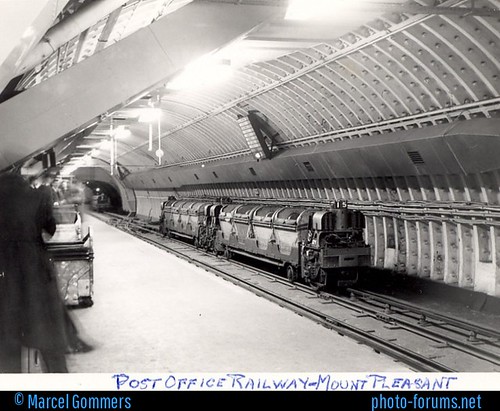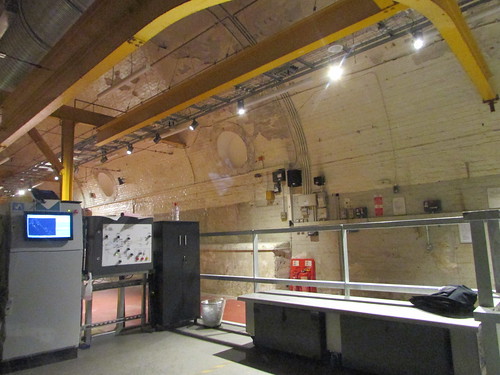Brief History
By 1911, worsening congestion on London's roads gave rise to the plan for an underground railway extending around 6.5 miles linking sorting offices at Paddington, Western District, West Central, Mount Pleasant (Clerkenwell), King Edward Building, Liverpool Street/Broad Street stations and Eastern District. A contract to build the railway was given to John Mowlem in 1915 but the shortage of materials and manpower caused suspension of the work in 1915 and the line was not completed until February 1927.
The line was 2-foot gauge, double-track, with reversing loops at both ends of the system and also at principal intermediate stations. In between stations, the two tracks were carried in a 9-foot diameter tunnel with sectional cast-iron lining at a depth of around 70 feet. At station approaches, 7-foot diameter single-line tunnels led to two parallel 25-foot diameter station tunnels at a shallower depth linked by cross-passages with lift access from the sorting office above. At either end of stations, gradients of 1 in 20 decelerated arriving trains and accelerated departing trains (this technique is also used on some of London Underground's lines). In general, each station tunnel accommodated a through line, a platform line and the platform itself, back-to-back with the other platform.
The very long platforms at Mount Pleasant were divided into three by two sets of scissors crossovers, allowing three trains in either direction to be simultaneously dealt with, independently arriving and departing using the through line.
The driverless trains were electric, powered from a central third rail at 440 volts d.c., reduced to 150 volts d.c. in stations (where the line speed limit of 40 m.p.h. was reduced to 7 m.p.h.).
At the west end of Mount Pleasant station, a double-track branch diverged and, climbing through a tunnel and turning through 180 degrees, terminated in the depot and workshop in a large basement area. For safety reasons, there was no third rail within the depot and trains were driven manually from a 'pulpit' via an overhead power system at 150 volts d.c.
In 1987, to celebrate 60 years operation, the railway was re-branded as 'Mail Rail' and the rolling stock was painted red but in 2003, the line was closed and 'mothballed'.
Rolling stock
The original electric rolling stock was 4-wheel long-wheelbase, resulting in excessive rail and flange wear. Between 1930 and 1936 an articulated design by 'Greenbat' (Greenwood and Batley) replaced the original rolling stock. The new locomotives were 4-wheel short wheelbase, with one axle driven and two small carrying wheels. A train comprised two of these locomotives joined back-to back by a chassis without wheels which carried the mail located on a pivot pin and load bearing plate on each locomotive.
An order for 34 replacement units with the same articulated layout was placed with 'Greenbat' in 1980 but, following that firm entering administration, the order was completed by Hunslet.
When the line was 'mothballed', the rolling stock comprised a mixture of 1930 and 1980 stock, with some later modifications.

Post Office Railway, Mount Pleasant showing 1930 rolling stock (Photo copyright: Marcel Gommers, via photo-forums.net).
Unofficial visitors
From time-to-time, the closed railway attracted the attentions of unofficial visitors or 'urban explorers' and there are various internet reports on these incursions, for instance, see Urban Ghosts or Beyond the Boundary.
A New Beginning
In 2013 the British Postal Museum announced plans to re-open part of the network as a tourist line and in September 2017 the Postal Museum opened in Phoenix Place with an optional out-and back ride on a section of Mail Rail.
Events of Thursday 30th November 2017
The Postal Museum
On 30th November 2017, I visited the Postal Museum and took the ride on Mail Rail. The main museum was busy, with plenty of adults and children enjoying the interactive exhibits outlining the history of the postal service, telegraphy and the public telephone service. There was a cafe, toilets and the inevitable souvenir shop. It was all well done and the staff were friendly and attentive so I enjoyed my brief visit although personally I prefer more old-fashioned interpretation.

The Postal Museum, Phoenix Place, London:
The Mail Rail Tourist Train
To avoid the possibility of queuing, I'd made a fixed time internet pre-booking to travel on Mail Rail, which has a separate street-level entrance on the opposite side of Phoenix Place leading into another souvenir shop in part of the huge Mount Pleasant Sorting Office.

Mount Pleasant Sorting Office, London:
The new tourist railway starts and finishes in the former depot underneath Mount Pleasant Sorting Office, reached by either stairs or a lift from the souvenir shop at street level.
Most of the original trackwork in the depot area has been removed, leaving a waiting area and museum space but many of the original fittings like overhead crane rails and the depot power system have been retained. A new train boarding/alighting platform has been built at the head of the double-track branch which leads to the main railway.

Postal Museum, Mail Rail: View from train boarding/alighting platform, showing control panels on the left and the brick-vaulted construction of the sub-surface former depot area.

Postal Museum, London: View of double-track branch leaving the train boarding/alighting platform which leads to the main railway.
Two new battery-powered trains have been provided. At the time of my visit, only one was in use. There is a driving cab at each end. Passengers enter individual compartments through side doors and are enclosed by curved, transparent plastic hinging roof sections, creating an effect rather like being in a aircraft cockpit. We boarded the train and staff closed the doors and roofs. After a warning over the public address from the driver not to lean against the doors and roofs (which have interlocks to stop the train), we set off, descending the branch leading to the main line.

Postal Museum, London: View from the Mail Rail tourist train as it descends from the depot area to join the Eastbound main line.
We stopped in the Eastbound platform at Mount Pleasant and watched an audio visual presentation about the history of the line from the train. As the journey proceeded, we paused a couple more times for another audio visual presentation and a pre-recorded announcement about the layout of the line.

Postal Museum, London: View from Mail Rail tourist train leaving Mount Pleasant.
The train took the reversing loop at the east end of Mount Pleasant station, offereing a brief view of the low level 'graveyard' sidings where old rolling stock is still stored, rejoining the main line now travelling westbound. Having passed through the long, unused westbound platform, we diverged onto the depot branch and finished our journey at the train boarding/alighting platform we'd left about twenty minutes earlier.
The Mail Rail Museum
The remaining exhibits in the depot area illustrated the history of the Post office Railway and the Travelling Post Office service.
The idea of transferring post short distances by rail had been tried as early as 1863 and the Postal Museum has one of the original 4-wheeled vehicles on display. This pneumatic system operated between Euston Station and Eversholt Street 1863-1866 and again in 1873-1874. The vehicles were propelled through a shallow-buried tube by air pressure from a steam-driven fan.
When the Post Office Railway opened in 1927, it had a manually-driven battery electric locomotive for maintenance use. This is on display.

Postal Museum, London: 1927 battery-electric locomotive.
The picture below shows the iconic 1930 articulated train, comprising locomotives joined back-to back by a chassis without wheels which carried the mail.

Postal Museum, London: 1930 articulated train.
At the rear of each locomotive, the chassis for mail was attached to a pivot pin with a load bearing plate.

Postal Museum, London: 1930 locomotive, showing method of attaching the chassis carrying mail. Note the electric pick-up 'shoe'.

Postal Museum, London: The original appearance of the 1980 locomotives. Various modifications were applied to some units.
An impressive miniature slide signalling frame which controlled the elaborate layout at Mount Pleasant is on display.

Postal Museum, London: The impressive 55-miniature slide signalling frame which controlled Mount Pleasant.
There was also a mock-up of a section of a Travelling Post Office sorting van (complete with moving floor) with the opportunity to try your hand at sorting on the move and a display of mail exchange apparatus.
Even if you're not a dyed-in-the-wool railway enthusiast, there was plenty of interest at the Postal Museum.
Track diagram
There a track diagram showing the line at the time it was mothballed in 2003 in the 'Quail Track Diagrams':-
'Railway Track Diagrams Book 5: Southern and TfL' Third Edition, published by TRACKmaps (ISBN 978-0-9549866-4-3).
Related posts on other websites
Although the links worked at the time this post was published, changes made by that website's owner may 'break' the link.
The Postal Museum.
London Post Office Railway.
My photograph albums
Where necessary, clicking on an image above will display an 'uncropped' view or, alternately, pictures may be selected, viewed or downloaded, in various sizes, from the albums listed:-
Postal Museum, London.
